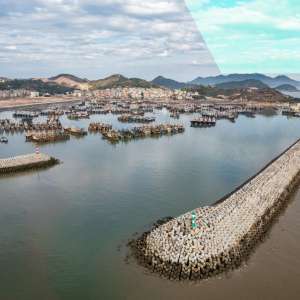Hong Kong to Busan: How to Ship Cargo Efficiently
Latest update on 17 June, 2024 by Caspian Ng– Marketing Analyst at FreightAmigo
Navigating the complexities of international shipping routes, particularly from Hong Kong to Busan, requires a deep understanding of logistics and the strategic application of industry best practices. This route, connecting one of the world’s busiest ports in Hong Kong with the bustling maritime gateway of Busan in South Korea, is vital for businesses looking to optimize their supply chains. Efficient cargo transportation between these two economic hubs can significantly impact competitive advantage, making it crucial for logistics managers and businesses to stay informed about the most effective shipping methods, incoterms, and regulatory considerations specific to Hong Kong and South Korea.
This article aims to provide a comprehensive guide on the various shipping options available for transporting cargo from Hong Kong to the Port of Busan. It will delve into the nuances of shipping routes and distances, compare the time and duration for different shipping methods, and analyze costs and pricing strategies. By understanding these critical components, businesses can make informed decisions, ensuring that their cargo reaches its destination efficiently and cost-effectively. Whether you’re a seasoned logistics professional or new to the field, this guide will equip you with the knowledge needed to navigate the complexities of shipping from Hong Kong to Busan.
Want To Compare The Best Express, Air Freight, Sea Freight, Rail Freight & Trucking Rates So As To Have Better Control On Cost?
Overview of Shipping Options
Shipping cargo from Hong Kong to Busan involves multiple options, each with distinct advantages and limitations depending on the urgency, cost, and nature of the goods being transported. Here, we explore the primary methods: air freight, sea freight, and road transport.
Air Freight
Air freight is the fastest shipping method available for transporting goods from Hong Kong to Busan. Flights may take approximately 1 day and 11 hours, departing from Shenzhen Bao’an International Airport and arriving at Gimhae International Airport. This method is particularly beneficial for time-sensitive shipments or perishable goods due to its speed and minimal handling, which significantly reduces the risk of damage. However, it’s important to note that air freight can be costly and has limitations on cargo size and weight, making it less suitable for larger, bulkier shipments.
Sea Freight
Sea freight offers a more economical solution for shipping large volumes of goods. The journey by ship from Da Chan Bay to Busan typically spans about 8 days and 12 hours. Ships depart every 1 to 2 weeks, making it a viable option for less urgent cargo. This method is ideal for heavy or bulky items that are not time-sensitive. Sea freight can be divided into Less than Container Load (LCL) and Full Container Load (FCL) options, with FCL providing a cost-effective solution for high-volume shipments. Despite its advantages in cost and capacity, sea freight’s longer transit times and potential for delays should be considered when planning shipments.
Road Transport
For shipments that need to be transported over shorter distances, road transport provides a flexible and direct method of delivery. Trucking services are capable of reaching both urban and rural areas, making it easier to deliver goods directly to the desired destination. Road transport can be particularly effective for medium-distance shipments and offers options like full truckload (FTL) and less than truckload (LTL) services. This mode of transport allows for special handling requests and frequent departures, ensuring that goods can be shipped on a schedule that fits the shipper’s needs.
Each shipping option presents unique benefits and challenges, and the choice of method will largely depend on the specific requirements of the shipment, including cost considerations, delivery deadlines, and the physical characteristics of the cargo. By carefully evaluating these factors, shippers can select the most appropriate and efficient method for their needs, ensuring that their goods arrive at their destination safely and economically.
Shipping Routes and Distances
Navigating the sea route from Hong Kong to Busan involves a journey of approximately 1,475 nautical miles. This strategic maritime path is traversed by vessels sailing through several significant bodies of water, including the South China Sea, Taiwan Strait, East China Sea, Hangzhou Bay, Yellow Sea, and the Sea of Japan. These waters are critical conduits for international shipping, linking two of Asia’s powerhouse economies.
The journey typically begins at the Port of Hong Kong, one of the most dynamic and busiest ports globally, strategically positioned on the South China Sea. From there, ships navigate northeast towards the Taiwan Strait, a vital passage that serves as the gateway between the South China Sea and the East China Sea. The route continues north through the bustling waters of the East China Sea, passing near Hangzhou Bay, an area known for its heavy maritime traffic due to its proximity to major Chinese industrial regions.
As ships progress on their journey, they enter the Yellow Sea, a marginal sea of the Pacific Ocean that serves as a critical buffer between China and the Korean Peninsula. The final leg of the maritime journey takes vessels through the Sea of Japan before reaching their destination at the Port of Busan. Known for its efficiency and state-of-the-art facilities, the Port of Busan stands as South Korea’s busiest and most important shipping hub, facilitating vast quantities of cargo throughput annually.
For businesses and logistics managers, understanding these routes and the distances involved is crucial for planning efficient shipping strategies. The total sea distance covered in this route is not just a mere traversal of waters but a well-coordinated journey through some of the most significant maritime checkpoints in Asia, impacting shipping times, costs, and overall logistics efficiency.
Time and Duration for Various Shipping Methods
Air Freight Duration
For those requiring rapid transport of goods from Hong Kong to Busan, air freight presents the quickest option. Flights depart from Shenzhen Bao’an International Airport and arrive at Gimhae International Airport, typically taking about 1 day and 11 hours. This route operates with a frequency of 1-2 flights per day, catering to urgent shipping needs and offering a swift solution for time-sensitive cargo.
Sea Freight Duration
When it comes to shipping larger volumes of goods, sea freight is a viable alternative, albeit with a longer transit time. The journey from Da Chan Bay to the Port of Busan spans approximately 8 days and 12 hours. Vessels set sail every 1 to 2 weeks, making this method suitable for less urgent shipments. This mode of transport is particularly advantageous for heavy or bulky items that do not require fast delivery, providing a balance between cost-efficiency and transit time.
Costs and Pricing
Understanding the costs associated with shipping from Hong Kong to Busan is crucial for businesses aiming to manage expenses while maintaining efficiency in their supply chain operations. This section provides a detailed look into the pricing mechanisms for different shipping methods, along with the environmental costs in terms of CO2 emissions.
Air Freight Costs
When opting for air freight, businesses should consider both the financial and environmental costs. The estimated CO2 emissions for sending cargo by air from Hong Kong to Busan range between 82kg to 120kg CO2 per 100kg of cargo. This emission level is calculated based on the total fuel burn of aircraft typically used on this route, divided by their total cargo capacity. Financially, air freight tends to be more expensive due to its speed and the logistics involved in airport handling and air transit. Prices can vary significantly based on fluctuating fuel costs, the weight and volume of the shipment, and the urgency of the delivery.
Sea Freight Costs
Sea freight is often more economical for large volumes of goods but comes with higher CO2 emissions. The estimated emissions for transporting a standard shipping container (1 TEU) from Hong Kong to Busan by sea are between 128kg to 162kg CO2. This figure is derived from the historical emissions data of container ships on this route, adjusted for their total capacity. In terms of pricing, sea freight costs are influenced by several factors including the type of goods, container size (LCL or FCL), seasonal demand, and fuel prices. Additionally, port fees and handling charges at both origin and destination ports can affect the overall cost.
Additional Costs and Considerations
Shipping costs are also impacted by the method of calculation used by couriers and freight companies, primarily based on the volumetric weight or the actual weight of the package, whichever is greater. Special handling requirements, insurance, and customs duties are additional factors that can influence the final price. For precise cost estimation, businesses can utilize tools like shipping calculators that offer real-time quotes from various couriers, factoring in discounts and pre-negotiated rates.
Understanding these costs and the associated CO2 emissions helps businesses make informed decisions about their shipping strategies, balancing financial costs with environmental impact and operational needs.
Conclusion
Through the comprehensive analysis of shipping options, routes, durations, and costs, this article has illuminated the complexities and considerations necessary for efficient cargo transportation from Hong Kong to Busan. By exploring the advantages and limitations of air freight, sea freight, and road transport, we have underscored the importance of selecting the most suitable shipping method based on the specific requirements of the cargo, including urgency, volume, and budget. The strategic insights offered here aim to empower businesses and logistics managers to make informed decisions, ensuring their goods are transported efficiently and cost-effectively.
Navigating the intricate shipping lanes and understanding the myriad of factors that impact the journey of cargo from one economic hub to another requires not just knowledge but also strategic partnerships. For businesses looking to optimize their shipping strategies from Hong Kong to Busan, it’s crucial to engage with a reliable logistics partner. If you wish to ship from Hong Kong to Busan, please go to the FreightAmigo page for inquiries. Leveraging the right expertise can significantly enhance operational efficiency, reduce costs, and minimize environmental impact, making your shipping process as smooth and effective as possible.
If You Wish To Ship From Hong Kong Port to Busan, Please Go To The FreightAmigo Page For Inquiries.
Cycle Time(Opens in a new browser tab)
If you have any inquiries on logistics / supply chain, feel free to contact FreightAmigo now:
Chat with us online | Hotline: +852 28121686 | WhatsApp: +852 27467829









































